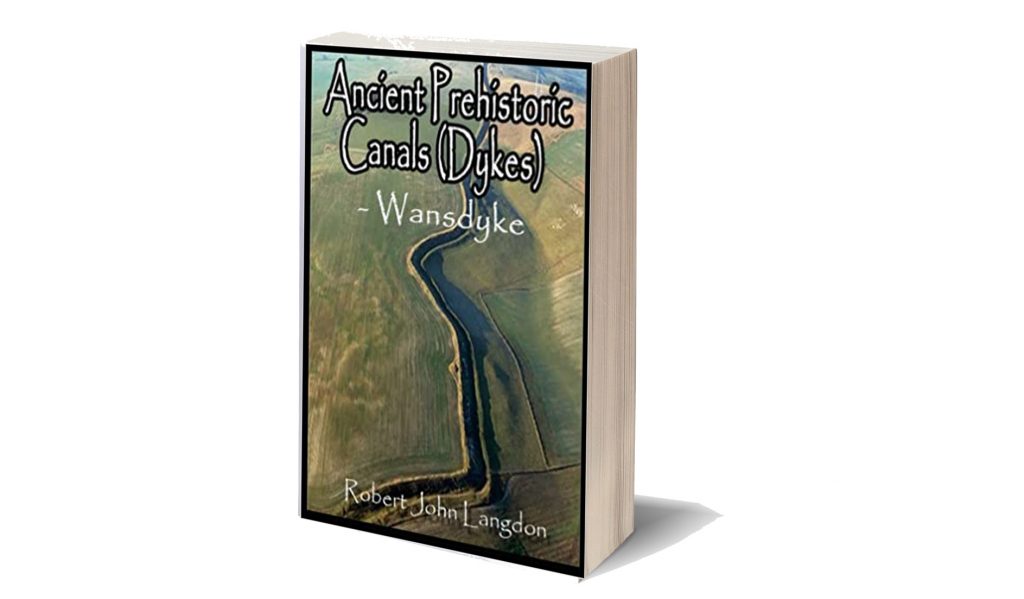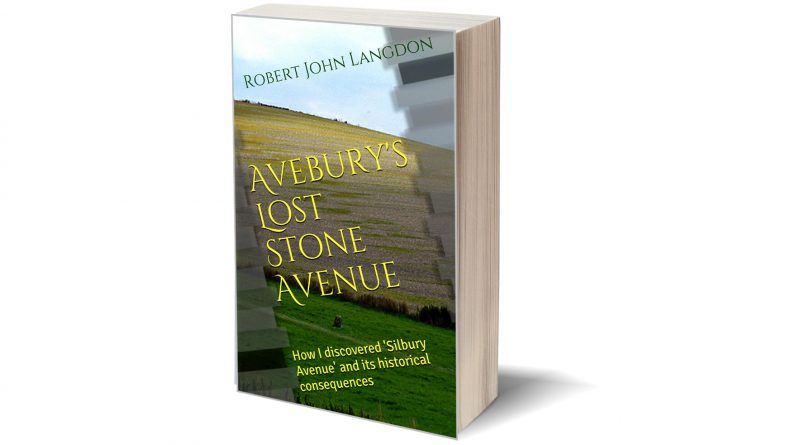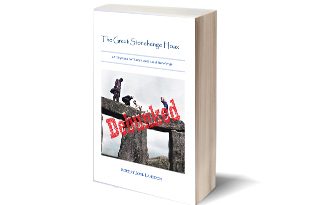Avebury’s Lost Stone Avenue – Flipbook
Unearth the Astonishing Secrets of Avebury’s Lost Stone Avenue!
In the heart of Wiltshire, England, lies the UNESCO World Heritage Site of Avebury, shrouded in mystery and wonder. For years, archaeologists and historians have delved into its enigmatic past, uncovering secrets buried beneath layers of time and earth. Yet, Avebury still held one final, astonishing revelation waiting to be unearthed, and it was the relentless pursuit of author and cartographer Robert John Langdon that would shed light on this long-forgotten secret.
Avebury, with its iconic stone circles and ancient monuments, has fascinated explorers and scholars for centuries. Among its well-known features are ‘West Kennet Avenue’ and ‘Beckhampton Avenue,’ both adorned with colossal stones that still stand as silent sentinels to an age long gone. These avenues have been pivotal in our understanding of Avebury’s past, connecting the spiritual and historical aspects of this sacred site. However, Langdon’s unrelenting quest to unravel Avebury’s mysteries led him down an uncharted path, one that would challenge conventional wisdom and rewrite the history of this remarkable place.
Langdon’s journey was marked by meticulous mapping and years of research, culminating in a hypothesis that would reshape our understanding of prehistoric Britain. He proposed that much of the British Isles had once been submerged in the aftermath of the last ice age, with these ancient sites strategically positioned along the ancient shorelines. His groundbreaking maps offered a fresh perspective, suggesting that Avebury had functioned as a bustling trading hub for our ancient ancestors. This audacious theory challenged the prevailing notion that prehistoric societies were isolated and disconnected, instead highlighting their sophistication in trade and commerce.
At the heart of this newfound understanding was the colossal enigma of Silbury Hill, the largest man-made monument in prehistoric Europe. Silbury Hill had confounded archaeologists for generations, with theories ranging from religious symbolism to ceremonial significance. Yet, Langdon boldly proclaimed that Silbury Hill had a far more practical and ingenious purpose—an ancient ‘Lighthouse’ that guided seafarers to the trading port of Avebury.
This notion, while revolutionary, was not without evidence. Langdon explained that his research indicated that Silbury Hill had indeed flooded in the distant past, making it logical to assume that it was repurposed as a harbor when the waters receded from the main Avebury site. The construction of Silbury Hill in stages, starting small and gradually growing taller, suggested a pragmatic approach rather than a symbolic one. According to Langdon, the height of the mound would have served as a beacon to attract ships and boats to the trading center, making it an essential feature for maritime navigation.
To many, Langdon’s claims may seem audacious, but they align with the findings of dowsers in 2011. At the top of the newly discovered Stone Avenue, these dowsers located a series of stone holes precisely where Langdon’s photographic evidence indicated their presence. The convergence of these findings strengthened Langdon’s case, providing compelling support for his audacious theory.
While confirmation through excavation is the next logical step, Langdon’s research has already ignited a vibrant discussion within the archaeological and historical communities. His perspective challenges our preconceived notions of prehistoric Britain, revealing a thriving civilization that engaged in far-reaching trade and commerce. The idea of Avebury as a bustling trading hub paints a picture of interconnectedness and shared culture, where societies traded not only goods but also ideas, beliefs, and traditions.
In the realm of historical discovery, it is often the audacious thinkers, the mavericks who dare to question established narratives, who propel our understanding forward. Robert John Langdon is undeniably one of these thinkers. With a deep passion for history and an unyielding commitment to his research, he has unearthed a hidden chapter in the story of Avebury—one that transcends the boundaries of time and offers fresh insights into our shared human history.
As Langdon’s trilogy, ‘The Stonehenge Enigma,’ continues to explore these groundbreaking theories, it beckons us to embark on a journey of discovery, to challenge our assumptions, and to embrace the possibility that the past is far more complex and interconnected than we ever imagined. Avebury, with its ancient stones and enigmatic avenues, continues to whisper its secrets to those who dare to listen, inviting us to see history through a new lens—one illuminated by the audacious vision of Robert John Langdon.

Wansdyke Flipbook
For more information about British Prehistory and other articles/books, go to our BLOG WEBSITE for daily updates or our VIDEO CHANNEL for interactive media and documentaries. The TRILOGY of books that ‘changed history’ can be found with chapter extracts at DAWN OF THE LOST CIVILISATION, THE STONEHENGE ENIGMA and THE POST-GLACIAL FLOODING HYPOTHESIS. Other associated books are also available such as 13 THINGS THAT DON’T MAKE SENSE IN HISTORY and other ‘short’ budget priced books can be found on our AUTHOR SITE. For active discussion on the findings of the TRILOGY and recent LiDAR investigations that is published on our WEBSITE you can join our FACEBOOK GROUP.
Other Blogs
1
a
- AI now Supports – Homo Superior
- AI now supports my Post-Glacial Flooding Hypothesis
- Alexander the Great sailed into India – where no rivers exist today
- Ancient Prehistoric Canals – The Vallum
- Ancient Secrets of Althorp – debunked
- Antler Picks built Ancient Monuments – yet there is no real evidence
- Antonine Wall – Prehistoric Canals (Dykes)
- Archaeological ‘pulp fiction’ – has archaeology turned from science?
- Archaeological Pseudoscience
- Archaeology in the Post-Truth Era
- Archaeology: A Bad Science?
- Archaeology: A Harbour for Fantasists?
- Archaeology: Fact or Fiction?
- Archaeology: The Flaws of Peer Review
- Archaeology’s Bayesian Mistake: Stop Averaging the Past
- Are Raised Beaches Archaeological Pseudoscience?
- Atlantis Found: The Mathematical Proof That Plato’s Lost City Was Doggerland
- ATLANTIS: Discovery with Dan Snow Debunked
- Avebury Ditch – Avebury Phase 2
- Avebury Post-Glacial Flooding
- Avebury through time
- Avebury’s great mystery revealed
- Avebury’s Lost Stone Avenue – Flipbook
b
- Battlesbury Hill – Wiltshire
- Beyond Stone and Bone: Rethinking the Megalithic Architects of Northern Europe
- BGS Prehistoric River Map
- Blackhenge: Debunking the Media misinterpretation of the Stonehenge Builders
- Brain capacity (Cro-Magnon Man)
- Brain capacity (Cro-Magnon Man)
- Britain’s First Road – Stonehenge Avenue
- Britain’s Giant Prehistoric Waterways
- British Roman Ports miles away from the coast
c
- Caerfai Promontory Fort – Archaeological Nonsense
- Car Dyke – ABC News PodCast
- Car Dyke – North Section
- CASE STUDY – An Inconvenient TRUTH (Craig Rhos Y Felin)
- Case Study – River Avon
- Case Study – Woodhenge Reconstruction
- Chapter 2 – Craig Rhos-Y-Felin Debunked
- Chapter 2 – Stonehenge Phase I
- Chapter 2 – Variation of the Species
- Chapter 3 – Post Glacial Sea Levels
- Chapter 3 – Stonehenge Phase II
- Chapter 7 – Britain’s Post-Glacial Flooding
- Cissbury Ring through time
- Cro-Magnons – An Explainer
d
- Darwin’s Children – Flipbook
- Darwin’s Children – The Cro-Magnons
- Dawn of the Lost Civilisation – Flipbook
- Dawn of the Lost Civilisation – Introduction
- Digging for Britain – Cerne Abbas 1 of 2
- Digging for Britain Debunked – Cerne Abbas 2
- Digging Up Britain’s Past – Debunked
- DLC Chapter 1 – The Ascent of Man
- Durrington Walls – Woodhenge through time
- Dyke Construction – Hydrology 101
- Dykes Ditches and Earthworks
- DYKES of Britain
e
f
g
h
- Hadrian’s Wall – Military Way Hoax
- Hadrian’s Wall – the Stanegate Hoax
- Hadrian’s Wall LiDAR investigation
- Hambledon Hill – NOT an ‘Iron Age Fort’
- Hayling Island Lidar Maps
- Hidden Sources of Ancient Dykes: Tracing Underground Groundwater Fractals
- Historic River Avon
- Hollingsbury Camp Brighton
- Hollows, Sunken Lanes and Palaeochannels
- Homo Superior – Flipbook
- Homo Superior – History’s Giants
- How Lidar will change Archaeology
i
l
m
- Maiden Castle through time
- Mathematics Meets Archaeology: Discovering the Mesolithic Origins of Car Dyke
- Mesolithic River Avon
- Mesolithic Stonehenge
- Minerals found in Prehistoric and Roman Quarries
- Mining in the Prehistoric to Roman Period
- Mount Caburn through time
- Mysteries of the Oldest Boatyard Uncovered
- Mythological Dragons – a non-existent animal that is shared by the World.
o
- Offa’s Dyke Flipbook
- Old Sarum Lidar Map
- Old Sarum Through Time…………….
- On Sunken Lands of the North Sea – Lived the World’s Greatest Civilisation.
- OSL Chronicles: Questioning Time in the Geological Tale of the Avon Valley
- Oswestry LiDAR Survey
- Oswestry through time
- Oysters in Archaeology: Nature’s Ancient Water Filters?
p
- Pillow Mounds: A Bronze Age Legacy of Cremation?
- Post Glacial Flooding – Flipbook
- Prehistoric Burial Practices of Britain
- Prehistoric Canals – Wansdyke
- Prehistoric Canals – Wansdyke
- Prehistoric Canals (Dykes) – Great Chesters Aqueduct (The Vallum Pt. 4)
- Prehistoric Canals (Dykes) – Hadrian’s Wall Vallum (pt 1)
- Prehistoric Canals (Dykes) – Offa’s Dyke (Chepstow)
- Prehistoric Canals (Dykes) – Offa’s Dyke (LiDAR Survey)
- Prehistoric Canals (Dykes) – Offa’s Dyke Survey (End of Section A)
- Prehistoric Canals (Dykes) – Wansdyke (4)
- Prehistoric Canals Wansdyke 2
- Professor Bonkers and the mad, mad World of Archaeology
r
- Rebirth in Stone: Decrypting the Winter Solstice Legacy of Stonehenge
- Rediscovering the Winter Solstice: The Original Winter Festival
- Rethinking Ancient Boundaries: The Vallum and Offa’s Dyke”
- Rethinking Ogham: Could Ireland’s Oldest Script Have Begun as a Tally System?
- Rethinking The Past: Mathematical Proof of Langdon’s Post-Glacial Flooding Hypothesis
- Revolutionising History: Car Dyke Unveiled as Prehistoric & the Launch of FusionBook 360
- Rising Evidence, Falling Rivers: The Real Story of Europe’s First Farmers
- Rivers of the Past Were Higher: A Fresh Perspective on Prehistoric Hydrology
s
- Sea Level Changes
- Section A – NY26SW
- Section B – NY25NE & NY26SE
- Section C – NY35NW
- Section D – NY35NE
- Section E – NY46SW & NY45NW
- Section F – NY46SE & NY45NE
- Section G – NY56SW
- Section H – NY56NE & NY56SE
- Section I – NY66NW
- Section J – NY66NE
- Section K – NY76NW
- Section L – NY76NE
- Section M – NY87SW & NY86NW
- Section N – NY87SE
- Section O – NY97SW & NY96NW
- Section P – NY96NE
- Section Q – NZ06NW
- Section R – NZ06NE
- Section S – NZ16NW
- Section T – NZ16NE
- Section U – NZ26NW & NZ26SW
- Section V – NZ26NE & NZ26SE
- Silbury Avenue – Avebury’s First Stone Avenue
- Silbury Hill
- Silbury Hill / Sanctuary – Avebury Phase 3
- Somerset Plain – Signs of Post-Glacial Flooding
- South Cadbury Castle – Camelot
- Statonbury Camp near Bath – an example of West Wansdyke
- Stone me – the druids are looking the wrong way on Solstice day
- Stone Money – Credit System
- Stone Transportation and Dumb Censorship
- Stonehenge – Monument to the Dead
- Stonehenge Hoax – Dating the Monument
- Stonehenge Hoax – Round Monument?
- Stonehenge Hoax – Summer Solstice
- Stonehenge LiDAR tour
- Stonehenge Phase 1 — Britain’s First Monument
- Stonehenge Phase I (The Stonehenge Landscape)
- Stonehenge Solved – Pythagorean maths put to use 4,000 years before he was born
- Stonehenge Stone Transportation
- Stonehenge Through Time
- Stonehenge, Doggerland and Atlantis connection
- Stonehenge: Discovery with Dan Snow Debunked
- Stonehenge: The Worlds First Computer
- Stonehenge’s The Lost Circle Revealed – DEBUNKED
t
- Ten Reasons Why Car Dyke Blows Britain’s Earthwork Myths Out of the Water
- Ten Things You Didn’t Know About Britain’s Prehistoric Flooded Past
- Ten thousand year old boats found on Northern Europe’s Hillsides
- Ten thousand-year-old boats found on Northern Europe’s Hillsides
- The “Hunter-Gatherer” Myth: Why It’s Time to Bury This Outdated Term
- The Ancient Mariners – Flipbook
- The Ancient Mariners – Prehistoric seafarers of the Mesolithic
- The Beringian Migration Myth: Why the Peopling of the Americas by Foot is Mathematically and Logistically Impossible
- The Bluestone Enigma
- The Cro-Magnon Cover-Up: How DNA and PR Labels Erased Our Real Ancestry
- The Dolmen and Long Barrow Connection
- The Durrington Walls Hoax – it’s not a henge?
- The First European Smelted Bronzes
- The Fury of the Past: Natural Disasters in Historical and Prehistoric Britain
- The Giant’s Graves of Cumbria
- The Giants of Prehistory: Cro-Magnon and the Ancient Monuments
- The Great Antler Pick Hoax
- The Great Chichester Hoax – A Bridge too far?
- The Great Dorchester Aqueduct Hoax
- The Great Farming Hoax – (Einkorn Wheat)
- The Great Farming Migration Hoax
- The Great Hadrian’s Wall Hoax
- The Great Iron Age Hill Fort Hoax
- The Great Offa’s Dyke Hoax
- The Great Prehistoric Migration Hoax
- The Great Stone Transportation Hoax
- The Great Stonehenge Hoax
- The Great Wansdyke Hoax
- The Henge and River Relationship
- The Logistical Impossibility of Defending Maiden Castle
- The Long Barrow Mystery
- The Long Barrow Mystery: Unraveling Ancient Connections
- The Lost Island of Avalon – revealed
- The Maiden Way Hoax – A Closer Look at an Ancient Road’s Hidden History
- The Maths – LGM total ice volume
- The Mystery of Pillow Mounds: Are They Really Medieval Rabbit Warrens?
- The Old Sarum Hoax
- The Oldest Boat Yard in the World found in Wales
- The Perils of Paradigm Shifts: Why Unconventional Hypotheses Get Branded as Pseudoscience
- The Post-Glacial Flooding Hypothesis – Flipbook
- The Post-Glacial Flooding Theory
- The Problem with Hadrian’s Vallum
- The Rise of the Cro-Magnon (Homo Superior)
- The Roman Military Way Hoax
- The Silbury Hill Lighthouse?
- The Stonehenge Avenue
- The Stonehenge Avenue
- The Stonehenge Code: Unveiling its 10,000-Year-Old Secret
- The Stonehenge Enigma – Flipbook
- The Stonehenge Enigma: What Lies Beneath? – Debunked
- The Stonehenge Hoax – Bluestone Quarry Site
- The Stonehenge Hoax – Flipbook
- The Stonehenge Hoax – Moving the Bluestones
- The Stonehenge Hoax – Periglacial Stripes
- The Stonehenge Hoax – Station Stones
- The Stonehenge Hoax – Stonehenge’s Location
- The Stonehenge Hoax – The Ditch
- The Stonehenge Hoax – The Slaughter Stone
- The Stonehenge Hoax – The Stonehenge Layer
- The Stonehenge Hoax – Totem Poles
- The Stonehenge Hoax – Woodhenge
- The Stonehenge Hospital
- The Subtropical Britain Hoax
- The Troy, Hyperborea and Atlantis Connection
- The Vallum @ Hadrian’s Wall – it’s Prehistoric!
- The Vallum at Hadrian’s Wall (Summary)
- The Woodhenge Hoax
- Three Dykes – Kidland Forest
- Top Ten misidentified Fire Beacons in British History
- Troy Debunked
- TSE – DVD Barrows
- TSE DVD – An Inconvenient Truth
- TSE DVD – Antler Picks
- TSE DVD – Avebury
- TSE DVD – Durrington Walls & Woodhenge
- TSE DVD – Dykes
- TSE DVD – Epilogue
- TSE DVD – Stonehenge Phase I
- TSE DVD – Stonehenge Phase II
- TSE DVD – The Post-Glacial Hypothesis
- TSE DVD Introduction
- TSE DVD Old Sarum
- Twigs, Charcoal, and the Death of the Saxon Dyke Myth
w
- Wansdyke – Short Film
- Wansdyke East – Prehistoric Canals
- Wansdyke Flipbook
- Wansdyke LiDAR Flyover
- Wansdyke: A British Frontier Wall – ‘Debunked’
- Was Columbus the first European to reach America?
- White Sheet Camp
- Why a Simple Fence Beats a Massive Dyke (and What That Means for History)
- Windmill Hill – Avebury Phase 1
- Winter Solstice – Science, Propaganda and Indoctrination
- Woodhenge – the World’s First Lighthouse?





Pingback: The Stonehenge Hoax - The Stonehenge Layer - Prehistoric Britain
Pingback: Silbury Hill - Prehistoric Britain
Pingback: Hollingsbury Camp Brighton - Prehistoric Britain
Pingback: The First European Smelted Bronzes - Prehistoric Britain
Pingback: The Great Stonehenge Hoax - Prehistoric Britain
Pingback: The Silbury Hill Lighthouse? - Prehistoric Britain
Pingback: Hadrian's Wall - Military Way Hoax - Prehistoric Britain
Pingback: Wansdyke - Short Film - Prehistoric Britain
Pingback: Archaeological Pseudoscience - Prehistoric Britain
Pingback: Section V - NZ26NE & NZ26SE - Prehistoric Britain
Pingback: Chapter 3 – Stonehenge Phase II - Prehistoric Britain
Pingback: The Henge and River Relationship - Prehistoric Britain
Pingback: Chapter 3 – Post Glacial Sea Levels - Prehistoric Britain
Pingback: Section J - NY66NE - Prehistoric Britain
Pingback: Section O - NY97SW & NY96NW - Prehistoric Britain
Pingback: Section I - NY66NW - Prehistoric Britain
Pingback: Chapter 2 – Variation of the Species - Prehistoric Britain
Pingback: Section A – NY26SW - Prehistoric Britain
Pingback: Section H - NY56NE & NY56SE - Prehistoric Britain
Pingback: Ancient Secrets of Althorp - debunked - Prehistoric Britain
Pingback: Section S - NZ16NW - Prehistoric Britain
Pingback: The Great Iron Age Hill Fort Hoax - Prehistoric Britain
Pingback: Ten thousand year old boats found on Northern Europe's Hillsides - Prehistoric Britain
Pingback: Brain capacity (Cro-Magnon Man) - Prehistoric Britain
Pingback: Great Chesters (Roman) Aqueduct (Part Two) - Prehistoric Britain
Pingback: Great Chesters Roman Aqueduct - Debunked (Part One) - Prehistoric Britain
Pingback: Homo Superior - History’s Giants - Prehistoric Britain
Pingback: Three Dykes - Kidland Forest - Prehistoric Britain
Pingback: Cissbury Ring through time - Prehistoric Britain
Pingback: Maiden Castle through time - Prehistoric Britain
Pingback: London (The Thames) through time - Prehistoric Britain
Pingback: Mount Caburn through time - Prehistoric Britain
Pingback: Stonehenge LiDAR tour - Prehistoric Britain
Pingback: Oswestry through time - Prehistoric Britain
Pingback: Avebury through time - Prehistoric Britain
Pingback: Durrington Walls - Woodhenge through time - Prehistoric Britain
Pingback: British Roman Ports miles away from the coast - Prehistoric Britain
Pingback: The Ancient Mariners - Prehistoric seafarers of the Mesolithic - Prehistoric Britain
Pingback: Old Sarum Through Time................ - Prehistoric Britain
Pingback: Was Columbus the first European to reach America? - Prehistoric Britain
Pingback: Alexander the Great sailed into India - where no rivers exist today - Prehistoric Britain
Pingback: Antler Picks built Ancient Monuments - yet there is no real evidence - Prehistoric Britain
Pingback: Sea Level Changes - Prehistoric Britain
Pingback: On Sunken Lands of the North Sea - lived the World's greatest Civilisation. - Prehistoric Britain
Pingback: Stone me – the druids are looking the wrong way on Solstice day - Prehistoric Britain
Pingback: Archaeological pulp fiction - has archaeology turned from science? - Prehistoric Britain
Pingback: BGS Prehistoric River Map - Prehistoric Britain
Pingback: The Long Barrow Mystery - Prehistoric Britain
Pingback: Six years ago archaeology made an astonishing discovery (Einkorn Wheat) - Prehistoric Britain
Pingback: Ten thousand-year-old boats found on Northern Europe's Hillsides - Prehistoric Britain
Pingback: Case Study - Woodhenge Reconstruction - Prehistoric Britain
Pingback: Stonehenge - Monument to the Dead - Prehistoric Britain
Pingback: The Stonehenge Avenue - Prehistoric Britain
Pingback: Stonehenge Phase I (The Stonehenge Landscape) - Prehistoric Britain
Pingback: New Home Land - for Homo Superior - Prehistoric Britain
Pingback: Landscape Transformation (raised river levels) - Prehistoric Britain
Pingback: The Maths - LGM total ice volume - Prehistoric Britain
Pingback: TSE DVD - The Post-Glacial Hypothesis - Prehistoric Britain
Pingback: TSE DVD - Introduction - Prehistoric Britain
Pingback: TSE DVD - Stonehenge Phase II - Prehistoric Britain
Pingback: TSE DVD - Durrington Walls & Woodhenge - Prehistoric Britain
Pingback: TSE DVD Old Sarum - Prehistoric Britain
Pingback: TSE DVD - Avebury - Prehistoric Britain
Pingback: TSE DVD - Antler Picks - Prehistoric Britain
Pingback: TSE - DVD Barrows - Prehistoric Britain
Pingback: TSE DVD - Dykes - Prehistoric Britain
Pingback: The Long Barrow Mystery: Unraveling Ancient Connections - Prehistoric Britain
Pingback: Stone transportation and Censorship - Prehistoric Britain
Pingback: The Great Prehistoric Migration Hoax - Prehistoric Britain
Pingback: Hadrian's Wall - the Stanegate Hoax - Prehistoric Britain
Pingback: Stone Money - Credit System - Prehistoric Britain
Pingback: OSL Chronicles: Questioning Time in the Geological Tale of the Avon Valley - Prehistoric Britain
Pingback: Stonehenge's The Lost Circle Revealed - DEBUNKED - Prehistoric Britain
Pingback: The Stonehenge Enigma - Flipbook - Prehistoric Britain
Pingback: The Great Stonehenge Hoax - Author's Book Listing
Pingback: Britain's First Road - Stonehenge Avenue - Prehistoric Britain
Pingback: Darwin's Children - the Cro-Magnons - Author's Book Listing
Pingback: Homo Superior - Author's Book Listing
Pingback: The Ancient Mariners - Author's Book Listing
Pingback: Dawn of the Lost Civilisation - Author's Book Listing
Pingback: Post-Glacial Flooding Hypothesis - Author's Book Listing
Pingback: Stonehenge Built 8300 BCE - Author's Book Listing
Pingback: Digging for Britain - Cerne Abbas - Prehistoric Britain
Pingback: Avebury Post-Glacial Flooding - Prehistoric Britain
Pingback: Digging for Britain Debunked - Cerne Abbas - Prehistoric Britain
Pingback: Echoes of Atlantis - Author's Book Listing
Pingback: Old Sarum - Author's Book Listing
Pingback: Echoes of Atlantis - Author's Book Listing
Pingback: Homo Superior (Cro-Magnons) - Author's Book Listing
Pingback: Prehistoric Rivers - Author's Book Listing
Pingback: Dykes, Ditches and Earthworks - Author's Book Listing
Pingback: Ancient Prehistoric Canals (Dykes) - Wansdyke - Author's Book Listing
Pingback: Gigantic Prehistoric Canals (Dykes) - Wansdyke - Prehistoric Britain
Pingback: The Problem with Hadrian's Vallum - Prehistoric Britain
Pingback: The Giant's Graves of Cumbria - Prehistoric Britain
Pingback: Section U - NZ26NW & NZ26SW - Prehistoric Britain
Pingback: Section T - NZ16NE - Prehistoric Britain
Pingback: Section R - NZ06NE - Prehistoric Britain
Pingback: Section Q - NZ06NW - Prehistoric Britain
Pingback: Section L - NY76NE - Prehistoric Britain
Pingback: Section K - NY76NW - Prehistoric Britain
Pingback: Section N - NY87SE - Prehistoric Britain
Pingback: Section G - NY56SW - Prehistoric Britain
Pingback: Section E – NY46SW & NY45NW - Prehistoric Britain
Pingback: Section C – NY35NW - Prehistoric Britain
Pingback: Section B – NY25NE & NY26SE - Prehistoric Britain
Pingback: Caerfai promontory fort - archaeological nonsense - Prehistoric Britain
Pingback: How Lidar will change Archaeology - Prehistoric Britain
Pingback: The Rivers of the Past were Higher – an idiot’s guide - Prehistoric Britain
Pingback: Mesolithic River Avon - Prehistoric Britain
Pingback: The Fury of the Past: Natural Disasters in Historical and Prehistoric Britain - Prehistoric Britain
Pingback: Archaeology in the Post-Truth Era - Prehistoric Britain
Pingback: Stonehenge Stone Transportation - Prehistoric Britain
Pingback: The Stone Transportation Hoax - Prehistoric Britain
Pingback: FREE Stonehenge LiDAR Maps - Prehistoric Britain
Pingback: Digging Up Britain's Past - Debunked - Prehistoric Britain
Pingback: Stonehenge, Doggerland and Atlantis connection - Prehistoric Britain
Pingback: The Stonehenge Enigma: What Lies Beneath? - Debunked - Prehistoric Britain
Pingback: Stonehenge: Discovery with Dan Snow Debunked - Prehistoric Britain
Pingback: Hollows, Sunken Lanes and Palaeochannels - Prehistoric Britain
Pingback: The Troy, Hyperborea and Atlantis Connection - Prehistoric Britain
Pingback: ATLANTIS: Discovery with Dan Snow Debunked - Prehistoric Britain
Pingback: The Oldest Boatyard in the World Uncovered - Prehistoric Britain
Pingback: The Giants of Prehistory: Cro-Magnon and the Ancient Monuments - Prehistoric Britain
Pingback: Beyond Stone and Bone: Rethinking the Megalithic Architects of Northern Europe - Prehistoric Britain
Pingback: The Great Chichester Hoax - A Bridge too far? - Prehistoric Britain
Pingback: Top Ten misidentified Fire Beacons in British History - Prehistoric Britain
Pingback: Why Archaeology is a dying discipline? - Prehistoric Britain
Pingback: The Stonehenge Hoax - Flipbook - Prehistoric Britain
Pingback: The Dolmen and Long Barrow Connection - Prehistoric Britain
Pingback: Chapter 2 – Stonehenge Phase I - Prehistoric Britain
Pingback: The Stonehenge Hospital - Prehistoric Britain
Pingback: Prehistoric Burial Practices of Britain - Prehistoric Britain
Pingback: The Logistical Impossibility of Defending Maiden Castle - Prehistoric Britain
Pingback: Prehistoric Canals - Wansdyke - Prehistoric Britain
Pingback: South Cadbury Castle - Camelot - Prehistoric Britain
Pingback: Professor Bonkers and the mad, mad World of Archaeology - Prehistoric Britain
Pingback: Dawn of the Lost Civilisation - Introduction - Prehistoric Britain
Pingback: Rethinking Ancient Boundaries: The Vallum and Offa's Dyke" - Prehistoric Britain
Pingback: Car Dyke - North Section - Prehistoric Britain
Pingback: Archaeological 'pulp fiction' - has archaeology turned from science? - Prehistoric Britain
Pingback: Mathematics Meets Archaeology: Discovering the Mesolithic Origins of Car Dyke - Prehistoric Britain
Pingback: White Sheet Camp - Prehistoric Britain
Pingback: The Mystery of Pillow Mounds: Are They Really Medieval Rabbit Warrens? - Prehistoric Britain
Pingback: Pillow Mounds: A Bronze Age Legacy of Cremation? - Prehistoric Britain
Pingback: Car Dyke - ABC News PodCast - Prehistoric Britain
Pingback: Archaeology: A Bad Science? - Prehistoric Britain
Pingback: Exploring Britain's Flooded Past: A Personal Journey - Prehistoric Britain
Pingback: 13 Things that don't make sense in Ancient History - flipbook - Prehistoric Britain
Pingback: Darwin’s Children - The Cro-Magnons - Prehistoric Britain
Pingback: Unmasking the "Iron Age Hillfort" Myth - Prehistoric Britain
Pingback: Hambledon Hill - NOT an 'Iron Age Fort' - Prehistoric Britain
Pingback: AI now supports my Post-Glacial Flooding Hypothesis - Prehistoric Britain
Pingback: AI now Supports - Homo Superior - Prehistoric Britain
Pingback: The Stonehenge Hoax - Station Stones - Prehistoric Britain
Pingback: The Stonehenge Hoax - Periglacial Stripes - Prehistoric Britain
Pingback: Stonehenge Hoax - Round Monument? - Prehistoric Britain
Pingback: Wansdyke: A British Frontier Wall - 'Debunked' - Prehistoric Britain
Pingback: The Stonehenge Hoax - Woodhenge - Prehistoric Britain
Pingback: The Stonehenge Hoax - The Slaughter Stone - Prehistoric Britain
Pingback: Stonehenge's Location -The Stonehenge Hoax - Prehistoric Britain
Pingback: The Stonehenge Hoax - The Ditch - Prehistoric Britain
Pingback: The Stonehenge Hoax - Moving the Bluestones - Prehistoric Britain
Pingback: The Stonehenge Hoax - Bluestone Quarry Site - Prehistoric Britain
Pingback: The Stonehenge Hoax - Totem Poles - Prehistoric Britain
Pingback: Stonehenge Hoax - Dating the Monument - Prehistoric Britain
Pingback: The Great Dorchester Aqueduct Hoax - Prehistoric Britain
Pingback: 2024 Prehistoric Britain Blog Review - Prehistoric Britain
Pingback: Statonbury Camp near Bath - an example of West Wansdyke - Prehistoric Britain
Pingback: Antonine Wall - Prehistoric Canals (Dykes) - Prehistoric Britain
Pingback: Mesolithic Stonehenge - Prehistoric Britain
Pingback: Why a Simple Fence Beats a Massive Dyke (and What That Means for History) - Prehistoric Britain
Pingback: The Great Antler Pick Hoax - Prehistoric Britain
Pingback: Revolutionising History: Car Dyke Unveiled as Prehistoric & the Launch of FusionBook 360 - Prehistoric Britain
Pingback: Debunking the Media Misinterpretation of the "Black Stonehenge Builders" Reports - Prehistoric Britain
Pingback: Archaeology: The Flaws of Peer Review - Prehistoric Britain
Pingback: Prehistoric Canals (Dykes) - Offa's Dyke (Chepstow) - Prehistoric Britain
Pingback: Britain's Giant Prehistoric Waterways - Prehistoric Britain
Pingback: Newgrange - Monument or Disneyland? - Prehistoric Britain
Pingback: Prehistoric Canals (Dykes) - Wansdyke (4) - Prehistoric Britain
Pingback: The Perils of Paradigm Shifts: Why Unconventional Hypotheses Get Branded as Pseudoscience - Prehistoric Britain
Pingback: Prehistoric Canals Wansdyke 2 - Prehistoric Britain
Pingback: Hidden Sources of Ancient Dykes: Tracing Underground Groundwater Fractals - Prehistoric Britain
Pingback: Oysters in Archaeology: Nature’s Ancient Water Filters? - Prehistoric Britain
Pingback: The Maiden Way Hoax - A Closer Look at an Ancient Road’s Hidden History - Prehistoric Britain
Pingback: The Roman Military Way Hoax - Prehistoric Britain
Pingback: The Vallum at Hadrian's Wall (Summary) - Prehistoric Britain
Pingback: Rethinking Ogham: Could Ireland's Oldest Script Have Begun as a Tally System? - Prehistoric Britain
Pingback: From the Rhône to Wansdyke: The Case for a Standardised Canal Boat in Prehistoric Britain - Prehistoric Britain
Pingback: Dyke Construction - Hydrology 101 - Prehistoric Britain
Pingback: 13 Things You Didn’t Know About Hillforts — The Real Story Behind Britain’s Ancient Earthworks - Prehistoric Britain
Pingback: Stonehenge Hoax – Summer Solstice - Prehistoric Britain
Pingback: Twigs, Charcoal, and the Death of the Saxon Dyke Myth - Prehistoric Britain
Pingback: The Stonehenge Code: Unveiling its 10,000-Year-Old Secret - Prehistoric Britain
Pingback: Silbury Avenue - Avebury's First Stone Avenue - Prehistoric Britain
Pingback: Rethinking The Past: Mathematical Proof of Langdon's Post-Glacial Flooding Hypothesis - Prehistoric Britain
Pingback: Case Study - River Avon - Prehistoric Britain
Pingback: Archaeology: A Harbour for Fantasists? - Prehistoric Britain
Pingback: The “Hunter-Gatherer” Myth: Why It’s Time to Bury This Outdated Term - Prehistoric Britain
Pingback: The Beringian Migration Myth: Why the Peopling of the Americas by Foot is Mathematically and Logistically Impossible - Prehistoric Britain
Pingback: Ten Things You Didn’t Know About Britain’s Prehistoric Flooded Past - Prehistoric Britain
Pingback: - Prehistoric Britain
Pingback: The Great Farming Migration Hoax - Prehistoric Britain
Pingback: Offa's Dyke Flipbook - Prehistoric Britain
Pingback: Wansdyke Flipbook - Prehistoric Britain
Pingback: Stonehenge Phase 1 — Britain's First Monument - Prehistoric Britain
Pingback: The Subtropical Britain Hoax - Prehistoric Britain
Pingback: Atlantis Found: The Mathematical Proof That Plato’s Lost City Was Doggerland - Prehistoric Britain
Pingback: Stonehenge Solved - Pythagorean maths put to use 4,000 years before he was born - Prehistoric Britain
Pingback: Stonehenge: The Worlds First Computer - Prehistoric Britain